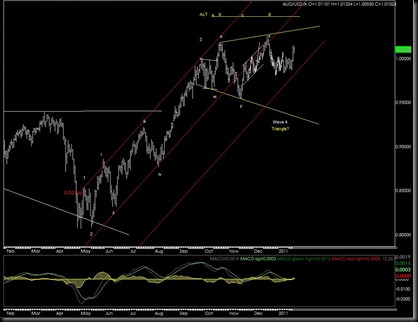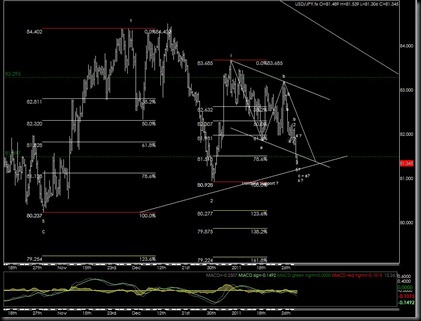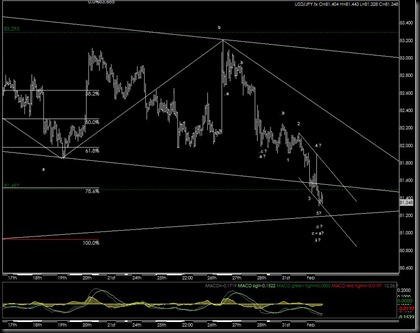Just because investment banks and stock brokerages say you should diversify doesn't make it true
February 7, 2011
By Elliott Wave International
Talk with an investment advisor, and what's the first piece of advice you will hear? Diversify your portfolio. The case for diversification is repeated so often that it's come to be thought of as an indisputable rule. Hardly anyone makes the case against diversifying your portfolio. But because we believe that too much liquidity has made all markets act similar to one another, we make that case. Heresy? Not at all. Just because investment banks and stock brokerages say you should diversify doesn't make it true. After all, their analysts nearly always say that the markets look bullish and that people should buy more now. For a breath of fresh air on this subject, read what Bob Prechter thinks about diversification.
* * * * *
Excerpt taken from Prechter's Perspective, originally published 2002, re-published 2004
Question: In recent years, mainstream experts have made the ideas of “buy and hold” and diversification almost synonymous with investing. What about diversification? Now it is nearly universally held that risk is reduced through acquisition of a broad-based portfolio of any imaginable investment category. Where do you stand on this idea?
Bob Prechter: Diversification for its own sake means you don’t know what you’re doing. If that is true, you might as well hold Treasury bills or a savings account. My opinion on this question is black and white, because the whole purpose of being a market speculator is to identify trends and make money with them. The proper approach is to take everything you can out of anticipated trends, using indicators that help you do that. Those times you make a mistake will be made up many times over by the successful investments you make. Some people say that is the purpose of diversification, that the winners will overcome the losers. But that stance requires the opinion that most investment vehicles ultimately go up from any entry point. That is not true, and is an opinion typically held late in a period when it has been true. So ironically, poor timing is often the thing that kills people who claim to ignore timing.
Sometimes the correct approach will lead to a diversified portfolio. There are times I have been long U.S. stocks, short bonds, short the Nikkei, and long something else. Other times, I’ve kept a very concentrated market position. My advice from mid-1984 to October 2, 1987, for instance, was to remain 100% invested in the U.S. stock market. During the bull market, I raised the stop-loss at each point along the wave structure where I could identify definite points of support. If I was wrong, investors would have been out of their positions. The potential was five times greater on the upside than the risk was on the downside, and five times greater in the stock market than any other area. Twice recently, in 1993 and 1995, I have had big positions in precious metals mining stocks when they appeared to me to be the only game in town. In 1993, it worked great, and they gained 100% in ten months. Diversification would have eliminated the profit. And every so often, an across-the-board deflation smashes all investments at once, and the person who has all his eggs in one basket, in this case cash, stays whole while everyone else gets killed.
* * * * *
Excerpt from The Elliott Wave Theorist, April 29, 1994
It is repeated daily that “global diversification” is self evidently an intelligent approach to investing. In brief, goes the line, an investor should not restrict himself to domestic stocks and bonds but also buy stocks and bonds of as many other countries as possible to “spread the risk” and ensure safety. Diversification is a tactic always touted at the end of global bull markets. Without years of a bull market to provide psychological comfort, this apparently self evident truth would not even be considered. No one was making this case at the 1974 low. During the craze for collectible coins, were you helped in owning rare coins of England, Spain, Japan and Malaysia? Or were you that much more hopelessly stuck when the bear market hit?
The Elliott Wave Theorist's position has been that successful investing requires one thing: anticipating successful investments, which requires that one must have a method of choosing them. Sometimes that means holding many investments, sometimes few. Recommending diversification so that novices can reduce risk is like recommending that novice skydivers strap a pillow to their backsides to “reduce risk.” Wouldn’t it be more helpful to advise them to avoid skydiving until they have learned all about it? Novices should not be investing; they should be saving, which means acting to protect their principal, not to generate a return when they don’t know how.
For the knowledgeable investor, diversification for its own sake merely reduces profits. Therefore, anyone championing investment diversification for the sake of safety and no other reason has no method for choosing investments, no method of forming a market opinion, and should not be in the money management business. Ironically yet necessarily given today’s conviction about diversification, the deflationary trend that will soon become monolithic will devastate nearly all financial assets except cash. If you want to diversify, buy some 6-month Treasury bills along with your 3-month ones.
Want More Reasons Why Diversification Should be Diverted from your Portfolio? Get our FREE report that explains the holes in the diversification argument. All you have to do is sign up as one of our Club EWI members. It's free, and it will give you access to more than this diversification report. Follow this link to instantly download this special free report, Death to Diversification – What it Means for Your Investment Strategy.
This article was syndicated by Elliott Wave International and was originally published under the headline On the Docket: The Case Against Diversification. EWI is the world's largest market forecasting firm. Its staff of full-time analysts led by Chartered Market Technician Robert Prechter provides 24-hour-a-day market analysis to institutional and private investors around the world.






